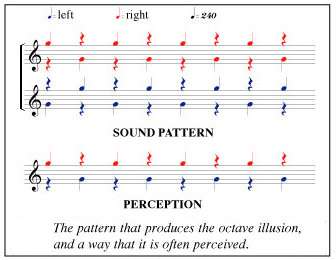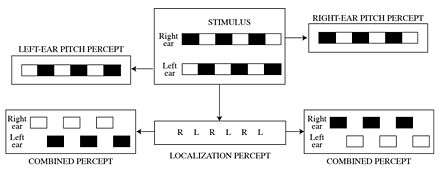Octave illusion

 |
Octave Illusion
Sound pattern inspired by the Octave Illusion but using C4 and C5 piano tones instead of sine waves as originally used by Deutsch (see link below). The piano example is also available as a MIDI file |
| Problems playing this file? See media help. | |
The octave illusion is an auditory illusion discovered by Diana Deutsch in 1973. It is produced when two tones that are an octave apart are repeatedly played in alternation (‘high-low-high-low’) through stereo headphones. The same sequence is played to both ears simultaneously; however when the right ear receives the high tone the left ear receives the low tone; and vice versa. Instead of hearing two alternating pitches, most subjects instead hear a single tone that alternates between ears while at the same time its pitch alternates between high and low.[1][2]
First Experiment
The two tones used were pitched at 400 Hz and 800 Hz, corresponding roughly to G4 and G5 in modern pitch notation. Each tone was played for 250 ms before switching ears. No gaps were allowed between tones. Both tones were therefore always present during the experiment; only the ears perceiving the high and the low tone at any one time changed repeatedly. After the initial test, the headphones were reversed, and the test was repeated.
Results

Eighty-six subjects were tested, and none perceived the tonal pattern correctly. Most subjects heard a single tone that alternated in pitch by an octave as it alternated between ears. When the earphones were reversed the ear that initially heard the high tone continued to hear the high tone, and the ear that initially heard the low tone continued to hear the low tone. Some subjects only heard a single tone that moved between ears but did not change in pitch, or changed very slightly. Several subjects heard various ‘complex’ illusions, such as two alternating pitches in one ear and a third pitch that sporadically occurred in the other ear.
Handedness also played an important role in the results. 58% of right-handed subjects and 52% of left-handed subjects heard a single pitch that switched between octaves as it switched between ears. Of the remaining subjects, nearly three times as many right-handers than left-handers heard a tone that switched ears but not pitch. Left-handed subjects were varied in their localization of the high and low tones, while right-handed subjects were much more likely to hear the high tone localized to their right ear during both tests.[2]
Deutsch proposed that when a single tone that alternates between octaves is heard, this illusion results from the combined operation of two decision mechanisms. First, to determine the tone's location, high pitches are given precedence; second, to determine the tone's pitch, tones in the dominant ear are given precedence over tones in the non-dominant ear.[3] This is known as the two-channel model, since it is proposed that the operation of two separate ‘what’ and ‘where’ decision mechanisms combine to produce the illusion. The model is illustrated here.
Further Experiments
In a further experiment, Deutsch examined the effect of handedness and familial handedness background on perception of the octave illusion.[4] The subjects were 250 students, and were classified both according to their handedness and also according to whether they had a lefthanded parent or sibling. It was found that righthanders were more likely to hear the high tone on the right (and the low tone on the left) than were mixed handers, and mixed handers were more likely to do so than lefthanders. And for all three handedness groups the tendency to hear the high tone on the right was greater for subjects with only righthanded parents and siblings than for those with left or mixed handed parents or siblings.
In another experiment, Deutsch and Roll explored the two-channel model in further detail.[5] They played 44 right-handed subjects a repeating pattern of tones pitched at 400 Hz and 800 Hz. This time the right ear was given three 800 Hz pitches alternating with two 400 Hz pitches, while the left ear simultaneously heard three 400 Hz pitches alternating with two 800 Hz pitches. A 250 ms pause was added between each successive tone combination. Subjects were asked to report how many high tones and how many low tones they heard, and in which ears they heard the tones. The results were consistent with the initial experiment.
In further experiments based on the same model Deutsch asked subjects to report whether the pattern was of the ‘high-low-high-low’ type, or the ‘low-high-low-high’ type. From this it could be determined which ear the subject was following for pitch. The amplitude of the unheard pitch was then manipulated in order to determine how large it needed to be, in order to counteract the effect, and it was found that a significant amplitude disparity was sometimes needed. It was also determined that, when both tones were not present at the same time, the illusion was broken.[6][7]
In yet other experiments, Deutsch varied the relative amplitudes of the high and low tones and asked subjects whether the pattern was of the ‘right-left-right-left-‘ type, or the ‘left-right-left-right’ type. From this it could be determined whether the subject was localizing the tone to the high or low pitch. Again, it was found that a large amplitude disparity was sometimes needed to counteract the effect.[8][9]
"Deutsch Illusion"
Brancucci, Padulo, and Tommasi [10] argue that the octave illusion should be renamed the Deutsch Illusion since, according to their findings, the illusion is not limited to the octave. They performed an experiment similar to Deutsch’s original, except the two tones that were used ranged in interval from a minor third to an eleventh. The tones were presented initially for 200 ms before switching ears, then again for 500 ms. While the illusion was present for several people at all intervals, the illusion occurred more often with wider intervals.
Criticism and Rebuttal
Chambers, Moss, and Mattingley believe that the illusion is caused by a combination of harmonic fusion and binaural diplacusis, a condition in which a pitch is perceived slightly differently between ears.[11] In experiments employing a few subjects, none reported the percept most commonly obtained by Deutsch’s subjects. This does not necessarily conflict with other studies, as the number of subjects used in this experiment was small and there are individual differences in perception of the illusion. The authors also argued that experiments conducted by others did not clarify whether the high tone and low tones were perceived as being an octave apart. They claimed, therefore, that their results were not consistent with those of Deutsch in relation to hand dominance and ear dominance versus location of pitch.
These criticisms were rebutted in two articles. Deutsch (2004a) [12] used a new procedure which provided more explicit documentation of the octave illusion; here musically trained subjects notated precisely what they heard. The experiment confirmed that subjects, on listening to the illusion, perceive an octave difference between the ears. This result cannot be explained by diplacusis, which refers to a difference of a fraction of a semitone between the ears. The article also documented that Chambers et al. used problematic procedures. In a further article, Deutsch (2004b) [13] showed that Chambers et al. made inappropriate comparisons with other phenomena of sound perception, and failed to consider several key findings that support Deutsch’s model. In addition, the octave illusion, in which an octave difference between the ears is perceived, has been replicated in several other laboratories. For example, Oehler and Reuter recently replicated the handedness correlate in a study of 174 subjects [14] Lamminmaki and Hari (2000) [15] and Lamminmaki et al. (2012) [16] in MEG studies provide an explanation of the illusion at the neurophysiological level that is in accordance with Deutsch’s two-channel model.
References
- ↑ Deutsch, D. (1974). "An auditory illusion". The Journal of the Acoustical Society of America. 55 (S1): S18–S19. doi:10.1121/1.1919587. ISSN 0001-4966.
- 1 2 Deutsch, D. (1974). "An auditory illusion". Nature. 251 (5473): 307–309. doi:10.1038/251307a0. PMID 4427654. PDF Document
- ↑ Deutsch, Diana (1975). "Musical Illusions". Scientific American. 233 (4): 92–104. doi:10.1038/scientificamerican1075-92. ISSN 0036-8733. PDF Document
- ↑ Deutsch, Diana (1983). "The octave illusion in relation to handedness and familial handedness background". Neuropsychologia. 21 (3): 289–293. doi:10.1016/0028-3932(83)90047-7. ISSN 0028-3932. PMID 6877583. PDF Document
- ↑ Deutsch, Diana; Roll, Philip L. (1976). "Separate "what" and "where" decision mechanisms in processing a dichotic tonal sequence.". Journal of Experimental Psychology: Human Perception and Performance. 2 (1): 23–29. doi:10.1037/0096-1523.2.1.23. ISSN 0096-1523. PMID 1262796. PDF Document
- ↑ Deutsch, Diana (1980). "Ear dominance and sequential interactions". The Journal of the Acoustical Society of America. 67 (1): 220. doi:10.1121/1.383731. ISSN 0001-4966.
- ↑ Deutsch, D. (1981). "The Octave Illusion and Auditory Perceptual Integration. In Tobias, J.V., and Schubert, E.D.". Hearing Research and Theory, Volume 1. 1: 99–142. PDF Document
- ↑ Deutsch, D. (1980). "Ear dominance and sequential interactions.". Journal of the Acoustical Society of America. 67 (1): 220–228. doi:10.1121/1.383731. PDF Document
- ↑ Deutsch, Diana (1978). "Lateralization by frequency for repeating sequences of dichotic 400- and 800-Hz tones". The Journal of the Acoustical Society of America. 63 (1): 184. doi:10.1121/1.381710. ISSN 0001-4966. PDF Document
- ↑ Brancucci, Alfredo; Padulo, Caterina; Tommasi, Luca (2008). ""Octave illusion" or "Deutsch's illusion"?". Psychological Research Psychologische Forschung. 73 (3): 303–307. doi:10.1007/s00426-008-0153-7. ISSN 0340-0727.
- ↑ Chambers, Christopher D.; Mattingley, Jason B.; Moss, Simon A. (2002). "The octave illusion revisited: Suppression or fusion between ears?". Journal of Experimental Psychology: Human Perception and Performance. 28 (6): 1288–1302. doi:10.1037/0096-1523.28.6.1288. ISSN 0096-1523.
- ↑ Deutsch, D. (2004). "The Octave Illusion Revisited Again.". Journal of Experimental Psychology: Human Perception and Performance. 30 (2): 355–364. doi:10.1037/0096-1523.30.2.355. ISSN 0096-1523. PMID 15053694. PDF Document
- ↑ Deutsch, D. (2004). "Reply to "Reconsidering evidence for the suppression model of the octave illusion," by C. D. Chambers, J. B. Mattingley, and S. A. Moss". Psychonomic Bulletin & Review. 11 (4): 667–676. doi:10.3758/BF03196618. ISSN 1069-9384. PDF Document
- ↑ Oehler, M.; Reuter, C. (2013). "The octave illusion and handedness: A replication of Deutsch's 1974 study". Musicae Scientiae. 17 (3): 277–289. doi:10.1177/1029864913493801. ISSN 1029-8649.
- ↑ Lamminmäki, Satu; Hari, Riitta (2000). "Auditory cortex activation associated with octave illusion". NeuroReport. 11 (7): 1469–1472. doi:10.1097/00001756-200005150-00021. ISSN 0959-4965.
- ↑ Lamminmäki, Satu; Mandel, Anne; Parkkonen, Lauri; Hari, Riitta (2012). "Binaural interaction and the octave illusion". The Journal of the Acoustical Society of America. 132 (3): 1747. doi:10.1121/1.4740474. ISSN 0001-4966.
Further References
- Deutsch, D. (1987). "Illusions for Stereo Headphones". Audio Magazine: 36–48. PDF Document
- Deutsch, D. (1983). "Auditory illusions, handedness, and the spatial environment". Journal of the Audio Engineering Society. 31: 607–618. PDF Document
- Deutsch, D. (2013). "Grouping mechanisms in music In D. Deutsch (Ed.)". The psychology of music, 3rd Edition: 183–248. doi:10.1016/B978-0-12-381460-9.00006-7. PDF Document